The Role of SEPP in Securing the Future of Telecommunications



Many people are excited about the arrival of 5G technology. With its advanced networking capabilities, 5G allows us to use countless advanced devices, including IoT products. Thanks to its enormous speed, downloading and uploading is a breeze, making it a real game changer when handling large files.
Unfortunately, like any other new technology, 5G comes with its fair share of risks. Perhaps the biggest current problem facing providers has to do with a lack of infrastructure. Although great efforts are being made to lay the foundation for 5G, we are still far from the same 4G coverage.
We also have to think about safety. Since this technology will connect several devices in one network, 5G would create numerous gaps that would be difficult to patch. So for everything to work, providers need SEPP or Security edge protection proxy technology.
In this article we explain SEPP protocols and why they are so important for the future of mobile and internet networks.
Importance of the SEPP protocol in 5G networks
SEPP is the primary defense provider used against potential threats to 5G networks. This creates a secure environment for the transfer of data between devices where every piece of information is encrypted. SEPP technology is critical to its conservation data integrity and confidentiality, so that no one can access messages sent online.
In theory, SEPP can ensure unfettered transmission of data from the source to the final recipient. It ensures that the person at the destination is the only one who has access to the information.
As you can imagine, SEPP is quite complex in nature. It consists of several aspects, providing users with complete protection of their signal data. SEPP not only prevents burglaries and data misuse, but also gives users complete privacy. The technology is based on key agreements and versatile authentication, supported by complex security algorithms.
The security edge protection proxy is not only effective, but has also become an industry standard. Mobile operators use SEPP to ensure network interconnectivity, a security system that works by roaming between 5G cores.
Biggest security concerns for 5G technology
While 5G is fantastic, it comes with a plethora of challenges. The most common problems are related to the huge number of IoT devices connected to a single network. Unfortunately, this is not the only problem you need to think about.
Threat surface
As the number of devices increases, it becomes increasingly difficult to protect users from outside threats. To make matters worse, many of these devices are interconnected with countless other devices, increasing the attack surface you need to protect against.
The basic example of this is IoT products, which depend on other IoTs to function properly. When an attacker compromises a single device within that network, they gain access to all other devices simultaneously.
Applications present a similar challenge. Each of them provides an access point for malicious factorsTherefore, providers must increase their defensive perimeter. You should be aware of possible data theft, property theft, espionage and spoofing, among other things.
Device security
Based on what we’ve said so far, the security of a single IoT device can be critical to the entire device network. Unfortunately, there are problems such as poor protection mechanisms and lack of encryption can convict multiple users and products at the same time.
Another common problem specifically related to IoT devices is the lack of security updates. Unlike mobile phones and PCs, these products are not regularly patched. In fact, many manufacturers don’t care about the problem because their main concern is providing short-term satisfaction.
Track location
Although 5G networks will eventually reach 4G coverage, the infrastructure is currently severely underdeveloped. The signals are especially weak in rural areas.
Another coverage issue has to do with the inability of the 5G signal to penetrate thick walls. As a result, even though there is extensive urban infrastructure, it does not provide an effective signal compared to 4G networks.
The lack of coverage makes it easier to detect users. The limited number of stations makes life easier for hackers, who can detect where the signal is coming from. Accurate identification leads to further privacy threats on top of existing inherent vulnerabilities.
Data security threats
The best thing about the 5G concept is its ability to handle massive amounts of data. Unfortunately, the high data load also exposes the network to liabilities. If the number of entries and endpoints increasesthis also applies to the risk to data.
Every piece of information transferred between users represents a potential vulnerability for the entire system. For example, a small problem with the encryption or the wrong recipient can affect data security.
Lack of compatibility
Although 5G has been around for several years, many users still rely on 4G. As a result, we have to think about backward compatibility between the older devices and networks and the newer ones. The main problem here is that the older systems do not receive regular support and updates, which increases the number of vulnerabilities.
In an ideal world, legacy network providers should fix these problems. However, as the world continues to develop, it is unlikely that this will be the case.
Network traffic simplification as a solution
While all of these challenges may seem insurmountable on paper, there are things that can help you. Smart carriers rely on SEPP as the best way to ensure secure connections between devices. The technology continues to work centralize and streamlining the entire management process, which is the best way to tackle its complexity.
SEPP shines at implementing policies across the board. It is excellent for monitoring devices and intercepting threats in advance. As such, SEPP is important not only for security, but also for improving the overall user experience.
Conclusion
5G brings a whole new set of problems for mobile and internet users. But with the help of SEPP you can significantly increase protection for the entire network. The technology does an excellent job of encrypting your data and ensuring higher confidentiality and integrity.




